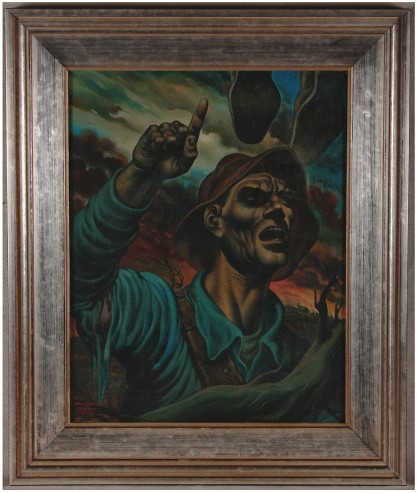

Burne Hogarth (1911-1996) is a legend in the comic book world for his mastery of anatomy and the dynamic forces which bring figures to life, and by extension made the jungle antics of Tarzan feel real to readers whose understanding of the “exotic” was continually shifting due to movies and air travel. By bringing a new level of sophistication and energy to the long-running serial, he turned the stories of a boy living outside the boundaries of civilization into the perfect escape for American’s fatigued by economic depression and war. Along with the body of work he created as a comic-book illustrator, he also influenced generations of artists through his innovative approach to “dynamic anatomy,” which he explained in detail in two popular textbooks and as an instructor at many art institutes. This dark and surreal view shows a tornado sweeping an unidentified figure into the night as a heavily muscled farmer, who appears to carry the olive drag belt of a soldier over his shoulder, helplessly curses the wind.

The image takes inspiration from the suffering Hogarth saw as a teenager growing up fatherless in the Depression-era midwest, and is profoundly influenced by the WPA regionalist movement. Like Thomas Hart Benton, Hogarth uses the landscape to represent the interior world of humanity, with the ravaged and menacing landscape showing the inability of even the strongest among us to prevent tragedy in life. Likely created for the Army Emergency Relief Fund, a group formed in 1943 to help the families of the enlisted with the medical, housing, and other unexpected problems which pop up in life and would normally be looked after by the head of a household, the AER was a direct way for civilians to help the needy on the homefront during wartime. The plight of soldiers and their families was a subject close to the heart of Hogarth, and at around the time he was at work on this painting, Hogarth was also developing the first art school for Veterans (which would become the highly regarded School of Visual Arts). Though dark in subject and execution, this image is above all a depiction of human empathy in hard times.

Bio: Hogarth began working at age 15 due to his father’s premature death. His drawing skills and art education brought him into contact with those in publishing, and it was with newspaper syndicates that Hogarth would earn a living, editing and creating advertising and panel illustrations in his teens. This work provided steady and, by 1929, crucial employment. Additionally, Hogarth’s first attempts at drawing a comic strip, Ivy Hemmanhaw, met with some success. As the Depression worsened, and at the urging of friends, Hogarth relocated to New York, continuing his work in newspaper illustration and editing as well as cartooning, drawing Charles Driscoll’s pirate adventure Pieces of Eight. In 1936 came the assignment that was to define Hogarth’s illustration career. With Tarzan, Hogarth melded classicism, expressionism, and narrative into a new dynamic sequential art. He drew the Tarzan Sunday page for twelve years, from 1937 to 1945 and from 1947 to 1950. This work has been reprinted often, most recently by NBM Publishing. Almost as long as he was a professional artist, Hogarth was also a teacher. Over the years, he was an instructor of drawing to a variety of students at a number of institutions and by 1944 Hogarth had in mind a school for returning World War II veterans. The Manhattan Academy of Newspaper Art was Hogarth’s first formal effort, and by 1947 he had transformed it into the Cartoonists and Illustrators School. This academy continued to grow, and in 1956 was again renamed, as the School of Visual Arts (SVA). It is now the world’s largest private institution of art. Hogarth designed the curriculum, served as an administrator, and taught a full schedule that included drawing, writing, and art history. It was in Hogarth’s classes that many of the Silver Age of comic books’ artists learned the advanced drawing techniques that formed a style still defining the superhero genre today. Hogarth retired from the SVA in 1970 but continued to teach at The Parsons School of Design and, after a move to Los Angeles, The Otis School and Art Center College of Design in Pasadena. During his years teaching, Hogarth authored a number of anatomy and drawing books that have become standard references for artists of every sort, including computer animators. Dynamic Anatomy (1958) and Drawing the Human Head were followed by further investigations of the human form. Dynamic Figure Drawing and Drawing Dynamic Hands completed the figure cycle. Dynamic Light and Shade and Dynamic Wrinkles and Drapery explored other aspects relative to rendering the figure. After more than 20 years away from strip work and being hailed in Europe as “the Michelangelo of the comic strip,” Hogarth returned to sequential art in 1972 with his groundbreaking Tarzan of the Apes, a large format hardbound book published by Watson Guptill in 11 languages. It marks the beginning of the sober volume of integrated pictorial fiction, what is currently understood to be a graphic novel. He followed with Jungle Tales of Tarzan, integrating previously unattempted techniques such as hidden, covert, and negative space imagery with Goethe-inspired color themes into a harmonious visual description, a pinnacle of narrative art. Date of Birth: December 25, 1911 Birthplace: Date of death: January 28, 1996
